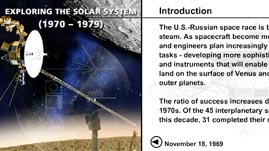Teachers' Domain - Digital Media for the Classroom and Professional Development
User: Preview

Source: NASA/JPL-Caltech. Note: This media resource is not served or maintained by Teachers' Domain.
The invention of the telescope forever changed astronomy by allowing exploration of the universe in far greater detail than was possible with human eyes alone. Technological advances of the twentieth century, such as computers, rockets, and other scientific instruments — made even more detailed views of the universe possible. In this interactive timeline from NASA, follow the development of space exploration through history.
During the past century, humans have evolved from Earth-bound scientists into true space explorers. Observational research is still conducted by telescopes from Earth's surface, but advanced technology has provided opportunities for exploring space from new perspectives. A variety of space missions have sent instruments, robots, and even people to visit and explore other solar system objects.
Since the successful 1957 launch of Sputnik, the first artificial satellite, into orbit around Earth, more and more countries have joined the space age. What began as a "space race" — in which the United States and the Soviet Union raced each other to demonstrate superiority in space technology — has evolved into a worldwide effort to find scientific answers. The International Space Station, a manned spaceflight project, relies on the cooperative efforts of the scientific and technological community of 16 nations.
Because of the challenge and expense of space travel, only a select number of people have had the opportunity to experience it. Robotic exploration of space is much more practical -- unmanned missions are able to explore the solar system in ways that humans cannot. Robots are ideal for space research because they can be designed and built expressly for the mission at hand. They are able to withstand the hostile conditions of space and to survive the long mission timelines. Equipped with scientific instruments such as telescopes, cameras, and spectrographs, robotic spacecraft are able to safely delve into space and radio back scientific data to researchers on Earth.
Different spacecraft perform particular scientific functions, and robotic space missions can be categorized into a few general categories. A flyby gathers as much data as possible as the spacecraft travels near the target object. An orbiter allows for a longer period of study because the spacecraft is placed into orbit around the object. Probes fall through atmospheres to study them, and landers gather data about the surfaces of the objects on which they land. Rovers also study the surfaces of objects, but they are mobile and thus can examine a greater area. Some missions combine multiple components, such as the Cassini-Huygens mission, which did a flyby of Venus and Jupiter while on its way to visit Saturn and its moons. Upon reaching Saturn, the Cassini orbiter studied the planet, while the Huygens probe studied the atmosphere of Saturn's moon Titan.
 Loading Standards
Loading Standards Teachers' Domain is proud to be a Pathways portal to the National Science Digital Library.
Teachers' Domain is proud to be a Pathways portal to the National Science Digital Library.
